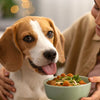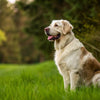How Soon After Exercise Can a Dog Eat? A Comprehensive Guide for Pet Owners
- Houndsy
Table of Contents
- Introduction
- The Importance of Timing Meals Around Exercise
- How Long Should You Wait?
- Creating a Balanced Feeding Schedule
- Feeding Dogs of Different Ages and Breeds
- Recognizing Signs of Digestive Issues
- Conclusion
- FAQ
Introduction
As devoted pet owners, we understand that exercise is a vital part of our dogs' health and well-being. Did you know that the timing of meals in relation to exercise can significantly impact your dog’s digestion and overall health? Many of us may not realize that feeding our furry friends too soon after exercise can lead to discomfort and even serious health issues like bloat. In this blog post, we’ll explore the best practices for feeding our dogs after physical activity, including how long to wait and why it matters.
By the end of this article, you will gain a deeper understanding of how to optimize your dog’s feeding schedule to ensure their health and happiness. We’ll discuss the science behind digestion, the implications of meal timing, and practical tips for creating an effective feeding routine. So, let’s dive in and reflect on our own feeding practices as we learn how to best care for our canine companions!
The Importance of Timing Meals Around Exercise
Feeding your dog at the right time is crucial for their digestive health. Just like humans, dogs need time to digest their food properly, and this process can be affected by exercise. When dogs engage in physical activity, blood flow is redirected to their muscles, which can slow down digestion. If food is introduced into the system while the body is still active, it can lead to discomfort and potential health risks.
Understanding Dog Digestion
Dogs generally take about four to eight hours to digest a meal, but this can vary based on several factors, including:
- Breed: Larger breeds tend to have slower digestion compared to smaller breeds.
- Age: Puppies have faster metabolism and may digest food more quickly than older dogs.
- Activity Level: Highly active dogs may have more efficient digestion due to increased metabolism during and after exercise.
Knowing these factors can help us determine the optimal window to feed our dogs after exercise.
Why Wait Before Feeding?
After exercise, it is important to allow your dog some recovery time before feeding them. This waiting period serves several purposes:
- Prevents Digestive Upset: When dogs eat too soon after exercise, their bodies may not be prepared to digest food effectively, leading to nausea, vomiting, or diarrhea.
- Reduces the Risk of Bloat: Bloat, or gastric dilatation-volvulus (GDV), is a life-threatening condition that can occur when a dog's stomach fills with air or food and twists. Feeding too soon after exercise increases the risk of this condition, especially in large or deep-chested breeds.
- Enhances Nutrient Absorption: Allowing a break between exercise and feeding gives your dog's body time to cool down and prepare for digestion, which can enhance nutrient absorption from their food.
How Long Should You Wait?
The general recommendation is to wait at least 30 to 60 minutes after exercise before feeding your dog. This allows their heart rate and breathing to return to normal and gives their digestive system a chance to stabilize.
Factors to Consider
The ideal waiting time can depend on various factors, including:
- Intensity of Exercise: If your dog has been engaged in strenuous activities, like running or playing fetch, it’s advisable to wait longer, perhaps even up to 90 minutes.
- Type of Exercise: Gentle walks may require a shorter wait time compared to more vigorous activities.
- Individual Dog Needs: Each dog is unique, and factors such as age, health condition, and breed should influence how long you wait before feeding.
Creating a Balanced Feeding Schedule
To ensure your dog gets the most out of their meals and exercise, consider implementing a structured feeding schedule. Here are some tips:
1. Establish Regular Meal Times
Consistency is key when it comes to feeding your dog. Aim to feed them at the same times each day, which helps regulate their digestion and hunger signals.
2. Plan Exercise Around Meal Times
If you know your dog’s feeding schedule, plan walks and playtime accordingly. For example, take your dog for a walk before their meal to avoid any issues with digestion afterward.
3. Monitor Your Dog’s Behavior
Pay attention to how your dog behaves after meals and exercise. If they exhibit signs of discomfort, such as lethargy or bloating, you may need to adjust your feeding schedule.
4. Use Quality Dog Food
High-quality dog food is essential for your pet’s health, especially after exercise. Look for foods that are rich in lean proteins, whole grains, and fresh vegetables to provide optimal nutrition. Our Houndsy Kibble Dispenser is designed to make portion control easy, ensuring your dog gets the right amount of food every time. Order Now.
Feeding Dogs of Different Ages and Breeds
It’s essential to tailor your feeding practices to suit your dog’s age and breed.
Puppies
Puppies typically need to eat more frequently than adult dogs, often requiring three to four meals a day. They may also tolerate shorter waiting periods before or after exercise. However, it’s still recommended to wait at least 30 minutes after playtime before offering food.
Adult Dogs
For healthy adult dogs, waiting 30 to 60 minutes after exercise is generally ideal. Adjust feeding schedules based on their activity level and overall health.
Senior Dogs
Older dogs often have slower digestion, so it’s wise to wait longer before feeding them after exercise. Waiting at least an hour can help ensure their digestive system is ready for food.
Recognizing Signs of Digestive Issues
As responsible dog owners, we must be vigilant about our pet's health. Here are some signs that your dog may be experiencing digestive problems:
- Restlessness or Discomfort: If your dog seems anxious or uncomfortable after eating or exercising, it may indicate digestive distress.
- Swollen Abdomen: A visibly distended stomach can be a sign of bloat, which requires immediate veterinary attention.
- Vomiting or Attempts to Vomit: If your dog is trying to vomit but not bringing anything up, this could indicate a serious issue.
- Rapid Breathing or Excessive Panting: These symptoms may indicate that your dog is in distress and needs immediate care.
If you notice any of these signs, do not hesitate to contact your veterinarian for guidance.
Conclusion
In summary, the timing of meals in relation to exercise is crucial for your dog's health. By waiting 30 to 60 minutes after exercise to feed your dog, you can prevent digestive issues and ensure that they get the most out of their meals. Remember to consider your dog’s individual needs, including age, breed, and exercise intensity when creating a feeding schedule.
As we strive to provide the best care for our pets, let’s reflect on our feeding practices and consider how we can improve them. If you’re looking for an innovative and stylish way to enhance your dog’s feeding experience, check out our Houndsy Kibble Dispenser. It’s designed for convenience, portion control, and aesthetic appeal, making mealtime a breeze! Explore the Houndsy Kibble Dispenser.
FAQ
Q: Can I feed my dog right after a walk?
A: It’s best to wait at least 30 to 60 minutes after exercise before feeding your dog to allow their digestive system to recover.
Q: What are the signs of bloat in dogs?
A: Signs of bloat include a swollen abdomen, restlessness, rapid breathing, and attempts to vomit without bringing anything up. If you notice these symptoms, seek veterinary care immediately.
Q: How long should I wait to exercise my dog after feeding?
A: Ideally, you should wait at least an hour after feeding before allowing your dog to engage in vigorous exercise.
Q: What should I feed my dog after exercise?
A: A balanced meal that includes lean proteins, whole grains, and vegetables is ideal for helping your dog recover after exercise.
Q: How can I ensure my dog is getting the right amount of food?
A: Using a reliable feeding tool like the Houndsy Kibble Dispenser can help you control portions and ensure your dog is receiving the appropriate amount of food based on their activity level. Learn More Here.












